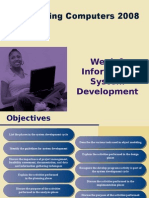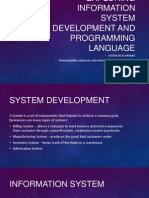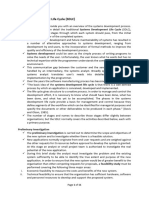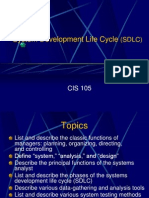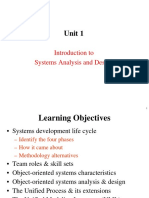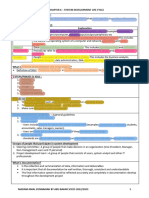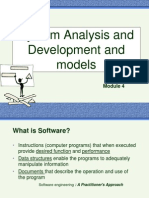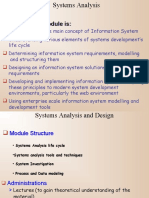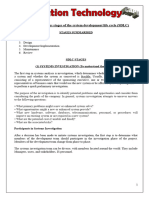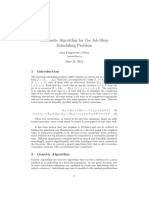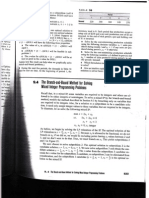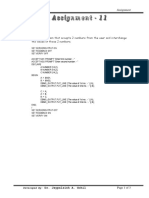Discovering
Computers 2009
Chapter 12
Information System
Development
Chapter 12 Objectives
List the phases in the system development cycle
Describe the various tools used in object modeling
Identify the guidelines for system development
Explain the activities performed in the design phase
Discuss the importance of project management,
feasibility assessment, documentation, and data and
information gathering techniques
Recognize the develop programs activity is part of
the system development cycle
Explain the activities performed
in the planning phase
Discuss the activities performed in the
implementation phase
Discuss the purpose of the activities
performed in the analysis phase
Discuss the purpose of the activities performed
in the operation, support, and security phase
Describe the various tools used in process modeling
Next
�What is the System Development Cycle?
What is an information system (IS)?
Hardware, software, data,
people, and procedures that
work together to produce
quality information
SystemSet of components
that interact to achieve
common goal
Businesses use many types of
systems
p. 620
Next
The System Development Life Cycle
What are the phases of the system development cycle?
Phase 2. Analysis
Phase 1. Planning
Review project requests
Prioritize project
requests
Allocate resources
Form project
development team
Conduct preliminary investigation
Perform detailed analysis activities:
Study current system
Determine user requirements
Recommend solution
Phase 5. Operating, Support,
and Security
p. 620 - 621 Fig. 12-1
Perform maintenance activities
Monitor system performance
Assess system security
Phase 3. Design
Acquire hardware
and software, if
necessary
Develop details of
system
Phase 4. Implementation
Develop programs, if necessary
Install and test new system
Train users
Convert to new system
Next
�What is the System Development Cycle?
What are guidelines for system development?
Arrange tasks into phases
(groups of activities)
Involve users (anyone for whom
system is being built)
Develop clearly defined standards (procedures
company expects employees to follow)
p. 621 - 622
Next
What is the System Development Cycle?
Who participates
in the system
development life
cycle?
p. 622 Fig. 12-2
Next
�What is the System Development Cycle?
What is a systems analyst?
Responsible for designing
and developing
information system
Liaison between users
and IT professionals
p. 622 - 623
Next
What is the System Development Cycle?
What is the project team?
Formed to work on project from beginning to end
Consists of users, systems analyst, and other IT professionals
Project leaderone member of the team who
manages and controls project budget and schedule
p. 623
Next
�What is the System Development Cycle?
What is project management?
Process of planning, scheduling, and controlling
activities during system development cycle
Project leader identifies elements for project
Goal, objectives, and
expectations, collectively
called scope
Required activities
Time estimates for each
activity
Cost estimates for each
activity
Order of activities
Activities that can take
place at same time
p. 623
Next
What is the System Development Cycle?
What is a Gantt chart?
Popular tool used to plan and schedule large, complex
projects
Click to view Web
Link, click Chapter 12, Click
Web Link from left
navigation, then click
PERT Charts
below Chapter 12
p. 623 - 624 Fig. 12-3
Next
�What is the System Development Cycle?
What is project management software?
Program used by project leaders to plan, schedule, and
control development projects
p. 624 Fig. 12-4
Next
What is the System Development Cycle?
What is feasibility?
Operational
feasibility
Measure of
how suitable
system
development
will be to the
company
Four feasibility
tests:
Schedule
feasibility
Economic
feasibility
(also called
cost/benefit
feasibility)
p. 625
Technical
feasibility
Next
�What is the System Development Cycle?
What is documentation?
Collection and summarization
of data and information
Includes reports, diagrams,
programs, and other deliverables
Project notebook contains all
documentation for single project
p. 625
Next
What is the System Development Cycle?
What are six data and information gathering techniques?
Review documentation
Observe
Survey
Interview
JAD sessions
Research
p. 625 - 626 Fig. 12-5
Next
�What Initiates the System Development Cycle?
What are some reasons to create or modify an
information system?
To correct problem
in existing system
To improve
existing system
Outside group may
mandate change
Competition can
lead to change
p. 626 - 627
Next
What Initiates the System Development Cycle?
What is a request for system services?
Formal request for
new or modified
information system
p. 627 Fig. 12-6
Also called
project request
Next
�Planning Phase
What is the planning phase?
Begins when steering committee receives project request
Steering
committee
decision-making
body for the
company
Function of committee:
Review and
approve project
requests
Prioritize
project requests
Allocate
resources
p. 629
Form project
development
team for each
approved
project
Next
Analysis Phase
What is the analysis phase?
Conduct preliminary
investigation, also
called feasibility
study
p. 630
Perform detailed
analysis
Next
�Analysis Phase
What is the preliminary investigation?
Determine exact nature of problem or improvement
and whether it is worth pursuing
Findings are presented in feasibility report, also known as a feasibility study
p. 630 Fig. 12-8
Next
Analysis Phase
What is detailed analysis?
1. Study how current system
works
2. Determine users wants, needs,
and requirements
3. Recommend solution
Sometimes called logical design
p. 631
Next
�Analysis Phase
What is process modeling?
Technique that describes processes that
transform inputs into outputs
Also called structured analysis and design
Entity-relationship diagrams
Three tools used for process modeling
Data flow diagrams
Project dictionary
Click to view Web
Link, click Chapter 12, Click
Web Link from left
navigation, then click
Process Modeling
below Chapter 12
p. 632 - 633
Next
Analysis Phase
What is an entity-relationship diagram (ERD)?
Tool that graphically shows connections among entities
in system
p. 632 Fig. 12-9
Next
�Analysis Phase
What is a data flow diagram (DFD)?
Tool that graphically shows flow of data in system
p. 632 - 633 Fig. 12-10
Next
Analysis Phase
What is a project dictionary?
Contains all
the documentation
and deliverables
of project
Helps keep track
of huge amount
of details in
system
Variety of
techniques to
enter items in
project dictionary
Structured English
Decision tables
Decision trees
Data dictionary
p. 633 - 635
Next
�Analysis Phase
What is Structured English?
Used to explain details of process
p. 633 Fig. 12-11
Next
Analysis Phase
What is a decision table?
Lists variety of conditions and actions that correspond
to each condition
p. 634 Fig. 12-12
Next
�Analysis Phase
What is a decision tree?
Shows conditions and actions graphically
p. 634 Fig. 12-13
Next
Analysis Phase
What is a data dictionary?
Stores name,
description, and
other details
about each data
item
p. 635 Fig. 12-14
Next
�Analysis Phase
What is object modeling?
Combines data with
the processes that act
on data into single
unit called an object
Objectan item that can
contain both data and
procedures that read or
manipulate the data
Sometimes called
object-oriented (OO)
analysis and design
Click to view Web
Link, click Chapter 12, Click
Web Link from left
navigation, then click
UML
below Chapter 12
p. 635
Uses Unified
Modeling Language
(UML)graphical tool
for documenting system
Next
Analysis Phase
What is a use case diagram?
Graphically shows how actors
interact with information system
p. 636 Fig. 12-15
Actoruser or
other entity
Use case
function that
actor can
perform
Next
�Analysis Phase
What is a class diagram?
Graphically shows classes and subclasses in system
Class is group of objects
Can have lower levels
called subclasses
p. 636 Fig. 12-16
Next
Analysis Phase
What is the
system proposal?
Assesses
feasibility
of each
alternative
solution
Recommends
the most
feasible
solution for
the project
p. 636
Presented to
steering
committee,
which decides
how system will
be developed
Next
�Analysis Phase
What are possible solutions?
Buy packaged softwareprewritten
software available for purchase
Write own custom softwaresoftware
developed at users request
Horizontal market
softwaremeets
needs of many
companies
Vertical market
softwaredesigned
for particular industry
Outsourcehave outside source
develop software
p. 637
Next
Analysis Phase
What is an example of outsourcing?
Using Internet solutions provider
Internet solutions provider provides Web hosting services
Click to view Web
Link, click Chapter 12,
Click Web Link from left
navigation, then click
Outsourcing below
Chapter 12
Click to view Web
Link, click Chapter 12, Click
Web Link from left
navigation, then click
Internet Solutions Provider
below Chapter 12
p. 637 Fig. 12-17
Next
�Design Phase
What is the design phase?
Acquire hardware and software
Develop all details of new or
modified information system
p. 639
Next
Design Phase
Video: A Tour of Lucasfilm Data Center
CLICK TO START
Next
�Design Phase
What is needed to acquire new hardware and software?
Identify all hardware and software requirements of new or
modified system
Identify technical
specifications
Solicit vendor
proposals
Test and evaluate
vendor proposals
Make a decision
p. 639
Next
Design Phase
What are three basic documents used to summarize
technical specifications?
Identifies
product(s)
you want
Request for quotation (RFQ)
Vendor selects
product(s) that
meet(s) your
requirements and
then quotes
price(s)
Request for proposal (RFP)
Request for information (RFI)
p. 639
Vendor quotes
price(s) for
listed
product(s)
Less formal method
that uses standard
form to request
information about
product or service
Next
�Design Phase
What is a turnkey solution?
Complete system provided by value-added reseller
Value-added reseller
(VAR) purchases products
from manufacturer and
then resells them, offering
additional services with
product
Authorized VARs must
meet certain manufacturerspecified requirements
Click to view Web
Link, click Chapter 12, Click
Web Link from left
navigation, then click
Value-Added Reseller
below Chapter 12
p. 639 Fig. 12-18
Next
Design Phase
How do systems analysts test software products?
References from vendor
Talk to current users of
product
Product demonstrations
Trial version of software
Benchmark test
measures performance
Click to view Web
Link, click Chapter 12, Click
Web Link from left
navigation, then click
Benchmark Tests
below Chapter 12
p. 640 Fig. 12-19
Next
�Design Phase
What is a detailed design?
Detailed design specifications for components in proposed solution
Sometimes called
physical design
Includes several activities
Database
design
Input and
output design
p. 641
Program
design
Next
Design Phase
What is a mockup?
Sample of input or output
that contains actual data
p. 641 Fig. 12-20
Next
�Design Phase
What is a layout chart?
Input or output that contains
programming-like notations
for data items
p. 641 Fig. 12-21
Next
Design Phase
What is a prototype?
Working model of
proposed system
Beginning a prototype
too early may lead to
problems
p. 642
Next
�Design Phase
What is computer-aided software engineering (CASE)?
Software tools designed to support activities of system
development cycle
Project repositoryStores
diagrams, specifications,
descriptions, programs, and
other deliverables
GraphicsEnables drawing
of diagrams
Quality assuranceAnalyzes
deliverables for accuracy
Click to view Web
Link, click Chapter 12, Click
Web Link from left
navigation, then click
Case Tools
below Chapter 12
p. 642 - 643
PrototypingCreates
models of proposed system
Code generatorsCreate
actual computer programs
from design specifications
HousekeepingEstablishes
user accounts and provides
backup and recovery
functions
Next
Design Phase
What is integrated computer-aided software
engineering (I-CASE)?
Integrated case products
p. 642 - 643 Fig. 12-22
Next
�Design Phase
What is an inspection?
Formal review by
project team and users
of any system development
cycle deliverable
Used to review detailed
design specifications
before they are given
to programming team
Identifies any errors
and allows IT personnel
to correct them
Used throughout entire
system development
cycle to review a variety
of deliverables
p. 643
Next
Implementation Phase
What is the implementation phase?
Purpose is to construct, or build, new or modified
system and then deliver it to users
Convert to new system
Train users
Install and test new system
Develop programs
p. 643
Next
�Implementation Phase
What is the program development cycle?
Programmers write
programs from
specifications
Follows six steps
Analyze
requirements
Document
solution
Design
solution
Validate
design
Test
solution
Implement
design
p. 643
Next
Implementation Phase
What are the four types of tests performed by system
developers?
p. 644
Unit Test
Systems test
Verifies each
individual program
works by itself
Verifies all programs
in application work
together
Integration Test
Acceptance Test
Verifies application
works with other
applications
Verifies the new
system works with
actual data
Next
�Implementation Phase
What is training?
Showing users exactly
how they will use new
hardware and software
in system
p. 644 Fig. 12-23
Next
Implementation Phase
What are conversion strategies?
Used to change from old system to new system
p. 644 - 645 Fig. 12-24
Next
�Operation, Support, and Security Phase
What is the operation, support, and security phase?
Provides ongoing assistance after system is implemented
Conduct post-implementation system reviewmeeting to find out if
information system is performing according to expectations
Perform Maintenance Activities
Monitor System Performance
Assess System Security
p. 646
Next
Operation, Support, and Security Phase
What is a computer security plan?
Summarizes in writing all of the safeguards that are in
place to protect a companys information assets
Click to view Web
Link, click Chapter 12,
Click Web Link from left
navigation, then click
Chief Security Officer
below Chapter 12
Identify all
information
assets of an
organization
Identify all
security risks
that may
cause an
information
asset loss
For each risk,
identify the
safeguards
that exist
to detect,
prevent, and
recover from a
loss
Click to view Web
Link, click Chapter 12, Click
Web Link from left
navigation, then click ICSA
below Chapter 12
p. 646
Next
�Summary of Information System Development
Phases in the system development
cycle
Activities that occur during the
entire system development cycle
Guidelines for system development
Chapter 12 Complete

